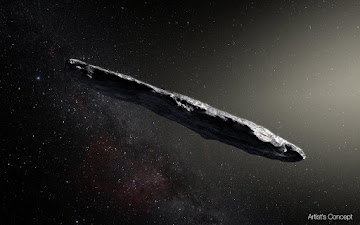At some point around the year 1837, an abnormal object passed at 1,000 AU from the Sun. (One Astronomical Unit, or AU, is the normal Earth-Sun distance.) For over a century, it proceeded undetected towards the Sun. At last, on October 19, 2017, we saw the guest.
Illustration of Oumuamua
Credit: Nasa
Oumuamua is nothing like anything else in the solar system. Leaving to the side the properties of its orbit, which solidly nails it down as the interstellar invader it genuinely is, the thing is only an abnormal object.
Oumuamua is a few hundred feet in length, yet exceptionally thin, shaped like a huge cigar. The item has a dull red tone to it, alike to the objects found in the far-off edges of our solar system, similar to Pluto.
Study Done by Astronomers
Astronomers expected the first interstellar guest would be a comet because they are brighter than space rocks, which makes them simpler to spot. In our nearby planet solar system — and probable others — approaching comets begin a long way from the Sun, where they easily get kicked out and enter another solar system because of the strong gravity of another star. But as scientists studied Oumuamua in more detail, it turns out it is not from the Kuiper belt or Oort cloud, but an object from another solar system
 |
| Telescope image of Oumuamua Credit: NASA |
Two things were clear: The object was in a hyperbolic orbit, which means it approaches our Sun just a single time and afterward shoots away again, never to return. In view of its orbit, it didn't begin in our nearby planet group by any means which further confirmed that it is from another solar system.
 |
| The trajectory of Oumuamua with respect to other objects Credit: Astronomy Now |
Also, the greatest mystery with respect to Oumuamua is that we even saw it by any stretch of the imagination. Think about the time of existence at work in a galaxy. Stars live and die throughout millions or billions of years. The formation of a system requires a huge number of years. It takes many years for even the quickest moving items to bounce from one star to another.
Hypothesis
Oumuamua's speed and trajectory were unlike any other object ever seen. This also led many to believe that Oumuamua might be an alien spacecraft.
We have also seen planets huge like Jupiter ejecting debris and small objects out of the solar system due to their gravitational force. There might be a possibility that in whatever solar system Oumuamua is from, it might get kicked out of the solar system by a huge planet.
Another possibility blames a planet like Neptune. These types of planets are usually far from their star and due to their gravity, they can form a belt of comets which sometimes get knocked off the solar system.
 |
| The Kuiper Belt Credits: NASA |
However the mystery of Omuamua is still not clear, it gave us a better understanding of the universe and let us know that how little we know about the universe.
Check my previous post: A massive star mysteriously disappeared

Comments
Post a Comment